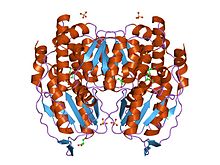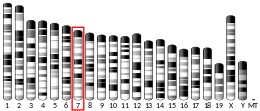Phosphoglucose isomerase
| Bacterial phosphoglucose isomerase C-terminal region |

crystal structure of phosphoglucose/phosphomannose isomerase from pyrobaculum aerophilum in complex with fructose 6-phosphate
|
| Identifiers |
| Symbol |
bact-PGI_C |
| Pfam |
PF10432 |
| InterPro |
IPR019490 |
| CDD |
cd05016 |
|
|
| GPI |
 |
|
|
| Identifiers |
| Aliases |
GPI, AMF, GNPI, NLK, PGI, PHI, SA-36, SA36, glucose-6-phosphate isomerase |
| External IDs |
OMIM: 172400 MGI: 95797 HomoloGene: 145 GeneCards: GPI |
|
|
| Gene location (Mouse) |
 |
| Chr. |
Chromosome 7 (mouse) |
|
|
| Band |
7 B1|7 19.46 cM |
Start |
34,201,330 bp |
| End |
34,230,336 bp |
|
|
|
| Orthologs |
| Species |
Human |
Mouse |
| Entrez |
|
|
| Ensembl |
|
|
| UniProt |
|
|
| RefSeq (mRNA) |
|
|
| RefSeq (protein) |
|
|
| Location (UCSC) |
Chr 19: 34.36 – 34.4 Mb |
Chr 19: 34.2 – 34.23 Mb |
|
PubMed search |
|
|
|
|
|
1NUH, 1IAT, 1IRI, 1JIQ, 1JLH
2821
14751
ENSG00000282019
ENSG00000105220
ENSMUSG00000036427
P06744
P06745
NM_001329910
NM_001329911
NM_008155
NP_001316839
NP_001316840
NP_032181
Glucose-6-phosphate isomerase (GPI), alternatively known as phosphoglucose isomerase (PGI) or phosphohexose isomerase (PHI), is an enzyme that in humans is encoded by the GPI gene on chromosome 19. This gene encodes a member of the glucose phosphate isomerase protein family. The encoded protein has been identified as a moonlighting protein based on its ability to perform mechanistically distinct functions. In the cytoplasm, the gene product functions as a glycolytic enzyme (glucose-6-phosphate isomerase) that interconverts glucose-6-phosphate (G6P) and fructose-6-phosphate (F6P). Extracellularly, the encoded protein (also referred to as neuroleukin) functions as a neurotrophic factor that promotes survival of skeletal motor neurons and sensory neurons, and as a lymphokine that induces immunoglobulin secretion. The encoded protein is also referred to as autocrine motility factor (AMF) based on an additional function as a tumor-secreted cytokine and angiogenic factor. Defects in this gene are the cause of nonspherocytic hemolytic anemia, and a severe enzyme deficiency can be associated with hydrops fetalis, immediate neonatal death and neurological impairment. Alternative splicing results in multiple transcript variants. [provided by RefSeq, Jan 2014]
...
Wikipedia







